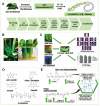Mucus-derived biomaterial dressings: a novel approach to accelerate wound healing
- PMID: 40860131
- PMCID: PMC12374547
- DOI: 10.7150/thno.115988
Mucus-derived biomaterial dressings: a novel approach to accelerate wound healing
Abstract
Wound management remains a clinical challenge due to the complexity of healing processes. Traditional dressings with passive protection mechanisms and modern synthetic alternatives often fail to recapitulate the dynamic biological interactions in the wound microenvironment. Mucus is a naturally widely available biomaterial, exhibiting superior bioactive properties as a viscoelastic gel-like substance. Notably, natural mucus derived from diverse biological sources has garnered significant attention as advanced wound dressings. This review explores the potential of natural mucus from animals, plants, microorganisms, and other complex sources as multifunctional wound healing platforms. By analyzing the therapeutic effects of natural mucus, we evaluate its key molecular mechanisms and performance metrics against clinical wound dressings. This establishes a scientific framework for mucus-inspired biomaterials design. The comprehensive assessment not only reveals the untapped potential of renewable biological resources in developing eco-friendly, high-performance wound care alternatives but also provides theoretical guidance for developing next-generation dressings with bioactive, self-adaptive, and environmentally responsive characteristics.
Keywords: adhesion; mucus; natural biomaterial; regeneration; wound healing.
© The author(s).
Conflict of interest statement
Competing Interests: The authors have declared that no competing interest exists.
Figures















Similar articles
-
Emergence of snail mucus as a multifunctional biogenic material for biomedical applications.Acta Biomater. 2025 Jun 15;200:21-46. doi: 10.1016/j.actbio.2025.05.006. Epub 2025 May 2. Acta Biomater. 2025. PMID: 40319989 Review.
-
Advances in biomaterials for wound care management: Insights from recent developments.Adv Colloid Interface Sci. 2025 Sep;343:103563. doi: 10.1016/j.cis.2025.103563. Epub 2025 May 31. Adv Colloid Interface Sci. 2025. PMID: 40479779 Review.
-
Dressings and topical agents for treating pressure ulcers.Cochrane Database Syst Rev. 2017 Jun 22;6(6):CD011947. doi: 10.1002/14651858.CD011947.pub2. Cochrane Database Syst Rev. 2017. PMID: 28639707 Free PMC article.
-
Hydrogel dressings for venous leg ulcers.Cochrane Database Syst Rev. 2022 Aug 5;8(8):CD010738. doi: 10.1002/14651858.CD010738.pub2. Cochrane Database Syst Rev. 2022. PMID: 35930364 Free PMC article.
-
Foam dressings for treating pressure ulcers.Cochrane Database Syst Rev. 2017 Oct 12;10(10):CD011332. doi: 10.1002/14651858.CD011332.pub2. Cochrane Database Syst Rev. 2017. PMID: 29025198 Free PMC article.
References
-
- Carter MJ, DaVanzo J, Haught R, Nusgart M, Cartwright D, Fife CE. Chronic wound prevalence and the associated cost of treatment in Medicare beneficiaries: changes between 2014 and 2019. J Med Econ. 2023;26:894–901. - PubMed
-
- Dong Y, Fu S, Yu J, Li X, Ding B. Emerging Smart Micro/Nanofiber-Based Materials for Next-Generation Wound Dressings. Adv Funct Mater. 2024;34:2311199.
-
- Joshi S, Maan M, Barman P, Sharely I, Verma K, Preet S. et al. Advances in biomaterials for wound care management: Insights from recent developments. Adv Colloid Interface Sci. 2025;343:103563. - PubMed
Publication types
MeSH terms
Substances
LinkOut - more resources
Full Text Sources

